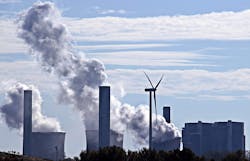According to NASA, the temperature of the earth is higher than it’s ever been. Since the Industrial Revolution, global temperatures have risen by 1.65°F (0.9°C). Most of this increase occurred over the last 35 years, with the hottest years on record coming within the last decade. The greenhouse gas effect is to blame.
The greenhouse gas effect refers to types of gas in the earth’s atmosphere that trap heat radiated from the earth that would otherwise be released into space. The gases are broken down into those that “force” climate change, and those that provide “feedback.” The gases include carbon dioxide (CO2), methane (CH4), nitrous oxide (N2O), and water vapor (H2O). Water vapor is a feedback gas, for the physical and chemical changes it undergoes in response to temperature shifts. Methane is more active than CO2 on a molecular level, but the quantity of CO2 in the atmosphere makes its effect more pronounced.
Prior to the Industrial Revolution, levels of CO2 had never risen above 300 parts per million. After the Industrial Revolution, CO2 levels spiked. Today, as much as 400 parts per million of the planet’s atmosphere is made of CO2. Some have theorized this warming could be a natural part of the earth’s temperature cycle. The United Nations’ Intergovernmental Panel on Climate Change, an independent group of 1,300 scientists who work together to understand and combat climate change, doesn’t agree. According to its Fifth Assessment Report, it’s more than 95% likely the warming of the planet is a direct result of human activities caused by things like burning fossil fuel.
It’s a Big Problem
The Paris Climate Agreement demonstrated world governments acknowledge the need to do something about climate change. Through the agreement, the 187 countries responsible for more than 97% of greenhouse gas emissions agreed to reduce emissions to cap global warming at 2°C, with 1.5°C being ideal. This means the U.S. would reduce emissions nationwide by 26% to 28% by 2025. The EU will reduce emissions by 40% by 2030. China and India will also reduce levels by 2030.
Greenhouse gas emissions by countries with climate targets (Image credit: NRDC.org)
Sounds good, doesn’t it? Countries will reduce fossil-fuel consumption, and we can all continue living as if nothing ever happened? Unfortunately, it’s not exactly that straightforward. In an almost 400-page report released by a panel of the National Academies of Sciences, Engineering, and Medicine, we have put off carbon emission reduction for so long, even if every county that signed the Paris Climate Agreement meets its goal, it will still not be enough to keep the planet cool enough to avoid catastrophe.
Pulling Out All Stops
Experts suggest a multifaceted approach. While nations scramble to replace coal-burning technologies with cleaner options, experts are calling for promising technologies that can make up the difference.
Here are the top three technologies for fighting climate change, excluding advances in clean energy.
Enhanced Oil Recovery and CO2 Capture
Some industries just love coal. Instead of using an alternative fuel, plants in Texas and Mississippi capture their CO2 emissions and prevent the gases from entering the atmosphere. The technology works by trapping the gigantic bubble of CO2 the arises from drilling, then sending it to oil fields. When CO2 hits the oil, the wells gush to the surface, theoretically allowing the CO2 to remain trapped underground.
Some scientists fear this methodology could result in manmade earthquakes. Others aren’t convinced that leaving CO2 to pool underground necessarily negates the effects of greenhouse gas.
Still, the methodology shows some promise. Through a partnership with the U.S. Department of Energy, agricultural giant Archer Daniels Midland now captures its CO2 emissions in a saltwater aquifer buried 7,000 ft below the facility. When mixed with ethanol, it could be used as a biofuel to eventually lower the operation’s gross CO2 emissions.
Other companies, like Carbon Recycling International of Iceland, “recycles” CO2 emissions into methanol, which can be used as fuel.
Carbon Capture and Storage
Perhaps the most promising technology is carbon capture and storage (CCS). According to the Carbon Capture and Storage Association, CCS technology can capture up to 90% of existing CO2 emission generation. As renewable energy continues to grow and CO2 emissions decrease, the CCS Association predicts carbon abatement will reach a negative state that enables the removal of carbon dioxide from the atmosphere.
CCS technologies work in three ways. First, the carbon is captured by some means, either from thin air or, as with the plants in Texas and Mississippi, physically captured in crude form. After that, the gas is transported and lastly stored in a way that prevents it from entering the atmosphere.
While CCS is promising, due to low funding for fuel-friendly innovations, many technologies remain at the research stage. Not all, however. A Swiss company named Climeworks became the first company to use CCS commercially. It captures CO2 emissions directly from the atmosphere and turns it into fertilizer for crops. The company has a goal of capturing 1% of global CO2 emissions by 2025.
Forests
As it turns out, the best technology for carbon capture isn’t a technology at all; at least not a manmade one. Natural forests remain the most effective system for CCS on the planet, and could help achieve 37% of the global climate target.
A single tree stores 48 pounds of carbon each year. Multiply that by the hundreds of trees in a typical forest, and natural forests are capable of storing the carbon emissions of entire countries.
Deforestation, however, continues to be a major concern for ecosystems, fauna, and the communities of low-income people who rely on local resources for survival. Thankfully, efforts are being made to protect the world’s forests. Through the REDD+ initiative, Brazil reduced deforestation enough over the past five years to shrink its carbon footprint more than any other nation during that period. Deforestation efforts can be difficult to implement, particularly in countries with rampant corruption. Efforts to reforest the planet will be necessary, however, to ensure the survival of our species.
It’ll Take All the Help We Can Find
There’s no single technology that can make up for the billions of tons of CO2 waste generated each year. Nations must make fervent efforts to reduce greenhouse gas emissions, and quickly. With enough pressure on local policymakers, and enough buy-in from venture capitalists and billionaire investors, we can restore the planet as the safe haven it has been for us, and can be for our children.





